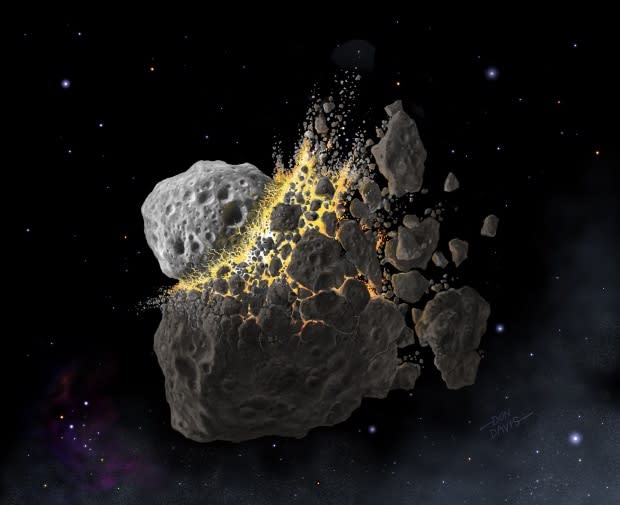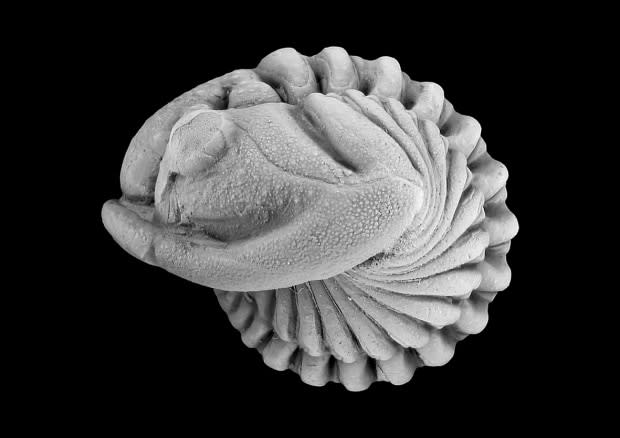Asteroid breakup 466 million years ago may have triggered ice age
Roughly 466 million years ago, an asteroid broke apart almost half a billion kilometres from Earth. And according to a new study published in Science Advances on Wednesday, that event may have played a vital role in shaping life on our planet.
Using previous studies on paleoclimate (the study of ancient climate), biodiversity and existing studies on the breakup of this 150-kilometre rock in the asteroid belt, a team of scientists suggests that the Mid-Ordovician ice age was greatly affected by dust from the asteroid that made its way to Earth.
They hypothesize that over a span of two million years, dust enveloped Earth, shrouding it from sunlight, which in turn caused a cooling effect that intensified the ice age and lowered sea levels.
Not all of this was bad, however. They also theorize that it subsequently led to a burst of marine biodiversity.

Earth is constantly being bombarded by dust and meteorites — including some that are very small, called micrometeorites. It's estimated that roughly 100 tonnes of space dust falls to Earth daily, including some from this asteroid that broke-up half a billion years ago.
But while this dust goes pretty much unnoticed today, 466 million years ago, roughly 10,000 times more dust was falling on Earth.
And this, the researchers believe, was vital in reshaping Earth.
"People always think of the global killer, but it can be the opposite," said Philipp Heck, co-author of the study and a curator at the Field Museum.
"I think this study shows we have to think outside of the box, and that a catastrophic event in the solar system can have very constructive consequences on other planets, and on Earth especially."
Accidental finding
In the 1980s, workers in a quarry in southern Sweden found meteorites contained in sedimentary rock. Birger Schmitz, lead author of this new study, trained the workers to identify further samples, and eventually more than 100 specimens were collected. Even more were found in the 1990s.
Chemical analysis of these and other, smaller meteorites yielded a surprise.
"Oxygen has three stable forms," said Heck, who is also an associate professor at the University of Chicago's department of the geophysical sciences.
"We can measure the abundance of three stable types of oxygen, and for us geochemists and cosmochemists, this is like a genetic fingerprint … and we used this to determine all of the meteorites found in the middle-Ordovician sediment, and all of the micrometeorites — including one asteroid that made a crater — they all came from one single source: the L-chondrite parent body."
There are three types of groups of ordinary chondrites: L-chondrite (low-iron), H-chondrite (high-iron) and LL-chondrites (low-iron, low-metal). L- and H-chondrites are considered "ordinary" chondrites as most meteorites collected today belong to these two groups.
But, as Heck puts it, "Before the breakup L-chondrites weren't ordinary."

In this new study, the researchers went back to Sweden to examine dust contained in sedimentary rock. This dust would be too small to have been noticed. What they found was this, too, matched the L-chondrite parent body. And it also coincided with the Great Ordovician Biodiversification Event (GOBE).
"Everything matches and … lead us to conclude that this extraterrestrial dust likely played an important role in cooling, and that triggered biodiversification. It's not that we have absolute proof of it, but we have very good evidence that it was an important factor."
Heck said that this new paper is merely a hypothesis about what could have contributed to the chilly period, and the subsequent rise in marine life, not that it was the only factor. But it's one with which he's fairly confident.
"This is an important hypothesis. I think it's very plausible," he said. "I think one of the things that needs to be done is to use our ground-truth data from the sediments, feed it into a paleoclimatological model and see how this plays out."
Roger Summons, a Schlumberger professor of geobiology at MIT, agrees that more investigation needs to be done.
"It's a very interesting paper and, from my knowledge of the authors' prior work, very solid," he said. "But the geological data comes from two sections in Sweden and Russia so, I guess, the obvious question to ask next is where else could these observations be checked."
Heck said another important part to this study is that it highlights that what happens elsewhere in the solar system could have profound effects on Earth.
"It's important to realize that not everything is a closed system," Heck said. "Extraterrestrial events can have important consequences."


